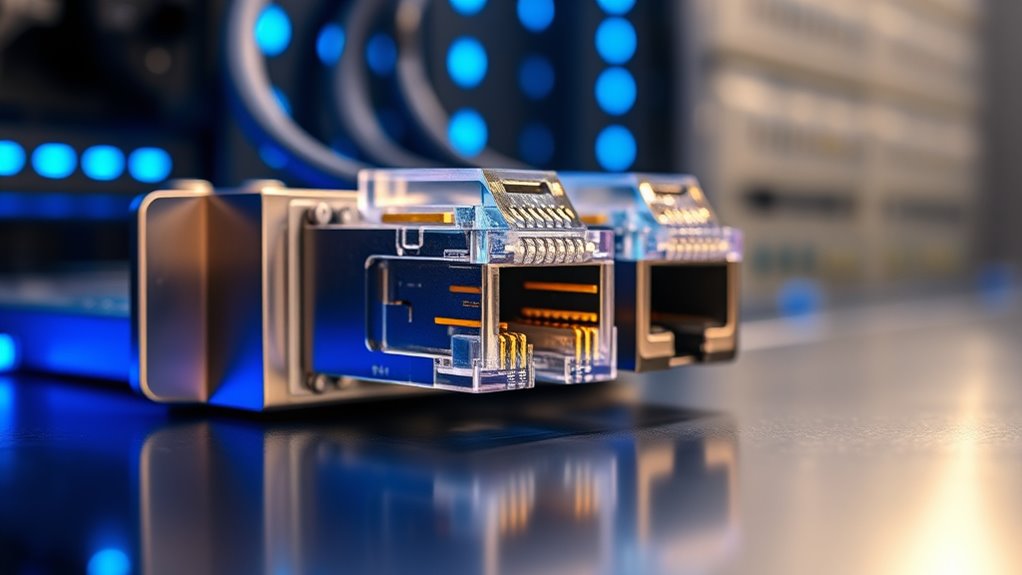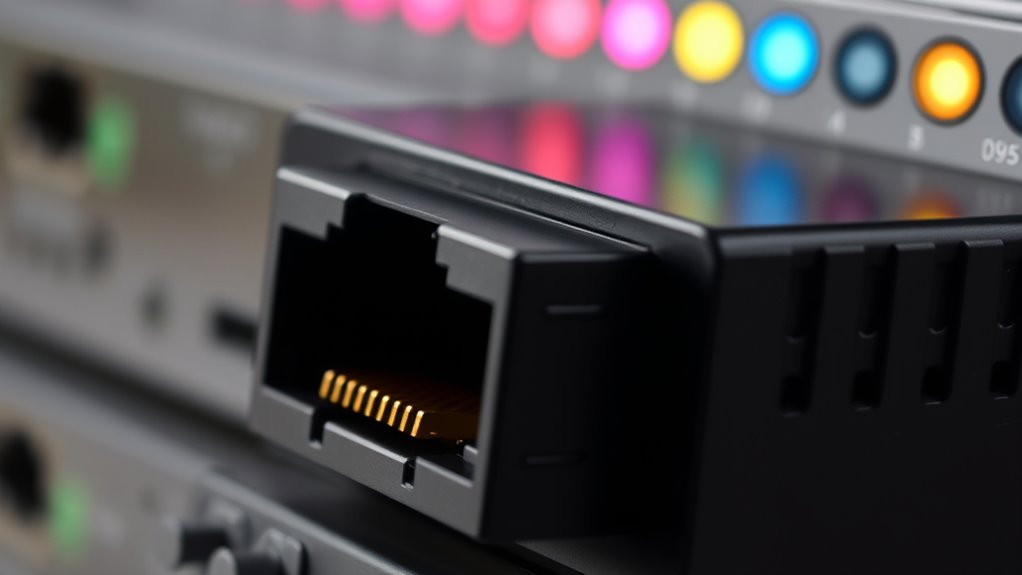Ethernet auto-negotiation is a process that allows your network devices to automatically determine the best connection settings, like speed and duplex mode, without manual input. It helps guarantee you get ideal performance, stability, and compatibility with minimal effort. The devices share their capabilities and agree on the highest common settings, reducing issues and maintaining smooth communication. If you want to understand how this works and why it’s important, there’s more to explore below.
Key Takeaways
- Auto-negotiation automatically determines the best link speed and duplex mode between connected Ethernet devices.
- Devices exchange supported capabilities to select the highest compatible speed and full or half duplex.
- It simplifies network setup, reducing manual configuration errors and ensuring optimal performance.
- Auto-negotiation enhances network adaptability, adjusting link parameters as devices or conditions change.
- Proper configuration of auto-negotiation is essential to prevent mismatches and maintain stable, high-quality connections.

Ethernet auto-negotiation is a crucial process that allows network devices to automatically establish the best possible link parameters, such as speed and duplex mode, without manual configuration. When you connect two devices, like a computer and a switch, auto-negotiation ensures they communicate efficiently by agreeing on ideal settings. This process simplifies network setup, reducing the need for manual adjustments and minimizing the risk of misconfigurations that can lead to connectivity issues.
During auto-negotiation, both devices exchange information about their capabilities. They share details about supported link speeds—such as 10 Mbps, 100 Mbps, 1 Gbps, or even higher—and duplex modes, which determine how data flows across the connection. Duplex mode can be either half-duplex, where data travels in one direction at a time, or full-duplex, allowing simultaneous bidirectional data transfer. The devices then negotiate to select the highest common link speed and duplex mode they both support, ensuring maximum performance and compatibility.
Devices exchange supported speeds and duplex modes to negotiate the best common connection settings.
Your network benefits greatly from this automatic process because it adapts to changing conditions without requiring your intervention. If you upgrade a switch or connect to a different device, auto-negotiation ensures that the link parameters adjust accordingly, maintaining ideal data transfer rates and preventing issues like collisions or data loss. For example, if one device supports 1 Gbps full-duplex and the other only supports 100 Mbps half-duplex, auto-negotiation will select the lower speed and duplex mode, ensuring a stable connection without manual configuration.
However, there are scenarios where auto-negotiation might not work perfectly. Sometimes, devices miscommunicate or don’t support the same features, leading to mismatched settings. In such cases, you might need to manually set the link speed or duplex mode to ensure compatibility. But generally, auto-negotiation is reliable and streamlines network management, especially in environments where devices frequently change or upgrade. Proper Ethernet auto-negotiation settings are vital for maintaining optimal network performance and avoiding potential issues.
Frequently Asked Questions
How Does Auto-Negotiation Affect Network Security?
Auto-negotiation can introduce security vulnerabilities by potentially allowing unauthorized access if attackers manipulate the process or exploit misconfigurations. When auto-negotiation isn’t properly secured, malicious actors might intercept or alter communication between devices, increasing the risk of security breaches. To protect your network, you should disable auto-negotiation on sensitive links and use static configurations, reducing vulnerabilities and preventing unauthorized access.
Can Auto-Negotiation Be Manually Disabled on All Devices?
You can definitely manually disable auto-negotiation on all devices, but it’s no small feat—it’s like trying to tame a wild beast! To do this, you need to check each device’s manual and verify compatibility because not all devices support manual disablement. Keep in mind, some network hardware automatically re-enables auto-negotiation after a restart, so continuous manual disablement requires consistent configuration and monitoring.
What Are Common Issues Caused by Auto-Negotiation Failures?
Auto-negotiation failures can cause cable incompatibilities and speed mismatches, leading to network issues. When it fails, devices might connect at lower speeds or not connect at all, disrupting data transfer. You might notice slow network performance or intermittent connections. To prevent this, verify your devices and cables support auto-negotiation properly, and consider manual configuration if persistent issues occur. Regularly updating firmware can also help resolve auto-negotiation problems.
How Does Auto-Negotiation Interact With Link Aggregation Protocols?
Think of auto-negotiation protocols as the handshake that sets the stage for link aggregation. When you enable link aggregation, auto-negotiation guarantees both devices agree on parameters like speed and duplex mode, creating a smooth partnership. This interaction helps the link aggregation protocols bundle multiple links seamlessly, boosting bandwidth and resilience. If auto-negotiation falters, your link aggregation could stumble, causing slower speeds or unstable connections.
Are There Performance Differences Between Auto-Negotiation and Manual Settings?
You might notice some performance variability with auto-negotiation compared to manual settings, especially if the devices don’t perfectly align their capabilities. Auto-negotiation simplifies configuration but can introduce unpredictability, while manual settings offer consistent performance by locking in specific speeds and duplex modes. However, manual setups increase configuration complexity, so consider your network’s stability needs versus ease of management when choosing between auto-negotiation and manual configuration.
Conclusion
By mastering the mechanics of Ethernet auto-negotiation, you empower your network with seamless speed, smooth synchronization, and savvy setup. Understanding how devices dynamically determine their connection capabilities allows you to troubleshoot, tune, and transform your network effortlessly. With knowledge and a little know-how, you can confidently conquer connectivity conflicts and create a reliable, resilient network that works wonderfully without worry. So, step into the world of auto-negotiation and streamline your system successfully.









